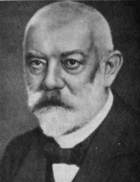
1872-1955
Johannes Hertel made a deep study of the Pancatantra as well as the Veda and Avesta. However, the conclusions he arrived at in the latter field were generally not accepted by scholars.
Johannes Hertel was born on 13.3.1872 in Zwickau, Saxony. In 1891, he went to Leipzig University to study Greek, Latin, German, English, French and Indology. He wrote a thesis Text und Verfasser des Hitopadesha ("Text and author of the Hitopadesha") and was awarded a Ph.D. degree for it in 1897. He taught modern languages in Zwickau and Doebeln before succeeding Windisch to the chair of Indology in Leipzig in 1919. He died in Leipzig on 27.10.1955.
While working as a teacher, Hertel devoted himself to the study of Indian fairy tales. In 1895, he translated the Hitopadesha. After a careful study of the manuscripts he came to the conclusion that a 14th century Nepali manuscript came closest to the original text. According to Hertel the Pancatantra was written around 200 B.C., and the Kashmiri Pancatantra version was the closest to the original. Hertel supported this conclusion by drawing up a genealogy of the text after making a thorough search for missing manuscripts.
In 1914, Hertel published Das Pancatantra, seine Geschichte und seine Verbreitung ("The Pancatantra, its history and its diffusion"). In this book, which was awarded a prize by the Strassburg University, Hertel discussed the spread of Indian fables to the West, East and South. In his opinion, Buddhist missionaries, wandering bards and gypsies were instrumental in spreading these tales abroad. Hertel confirmed the theories put forward in 1859 by Benfey.
Hertel's inaugural lecture was on Shvetambara Jain literature from Gujarat. He maintained that Jain narrative literature was of a standard higher than that of the Buddhists. The Jains wrote for a wider audience not limited to the educated as did the Brahmins. They used easier languages like Prakrit, Apabhramsa, Hindi, Gujerati and Rajasthani in the fairy tales, parables, and fables.
Hertel then turned to a class of literature that scholars had hitherto not taken note of -picturesque novels and farces. In 1921, he published Bharata-kadvatrimsika, a collection of 32 popular tales. Hertel stated that the author was a Jain writer of the 14th century. He also translated the Mattavilasana Prahasana, which was ascribed to the 7th century.
When Hertel was appointed professor in Leipzig, he took up the study of the Rigveda. From 1924 onwards he published a journal Indo-lranische Quellen und Forschungen ("Indo-IraniaH Sources and Research"), in which his papers on Vedic and Avestan subjects appeared. He considered that Veda and Avesta should be studied together, not separately. His first step was to determine the geographical location and the period to which the text belonged. According to Hertel, fire, sun, and light played an important role in both Veda and Avesta. They were symbols of what was considered good and beautiful in the Iranian and Vedic languages. The original home of the Aryan people must therefore have been in a cold country. When the Vedic Aryans settled in India these concepts underwent a gradual change. From the fact that the metres and accents in Veda and Avesta correspond to each other, Hertel deduced that the Vedas were composed in the middle Iranian period outside India. In Hertel's opinion the fact that Indian flora and fauna find no mention in the Veda corroborated this view.
Hertel was a prolific writer who wrote a large number of articles and book reviews. He also translated Indian poems and stories into German.
A bibliography of Hertel's works was published by Weller in the "Proceedings of the Saxon Academy", 1954-56.